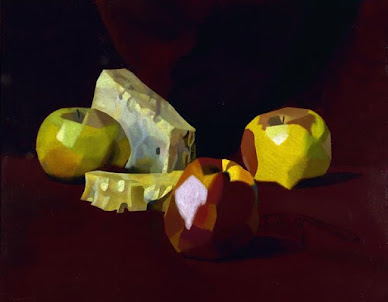For some unfathomable reason the British writer G.K. Chesterton started the rumor, "Poets have been mysteriously silent about cheese."
In this still life by Luis Fernandez, there is Swiss cheese in front, I think ,and a brick of Stilton (possibly) in back. As for those apples, all angles and marmoreal faceted surfaces, they remind me of glass paperweights. Welcome to the world of Cubist cheese. Salvador Dali's notorious limp watches in The Persistence of Memory (1931), were inspired by Camembert. Cheese in art has a long and intriguing history.
How cheese is aged is a story in itself. Affinage is the process of aging cheese in a cave; an affineur is a person who tends these works in progress for months or even years, until they are ready to be eaten. Other French terms are fromage (cheese), fromager (a cheese monger) and fromagerie (cheese shop). All cheeses that have rinds need to be aged in a cave. And the rinds need to be carefully monitored, high humidity maintained and mold evenly brushed over the surface of the wheel at regular intervals. What this means is that during the pandemic, affineurs are essential workers.
On Sunday, September 26, 2021, a group calling themselves 315 Foodies (for the Central New York Area Code 315) met to assemble what the Guinness Book of World Records was on hand to certify as the world's longest charcuterie board at 315 feet. Cheese mongers from around the region took part, using wooden cheese boards that interlocked like puzzle pieces; each board one foot long.
Before there was cheese in upstate New York, there was water. About 11,000 BCE, a glacial waterfall carved out the gorge where Little Falls now stands. From this point, rivers to the east drain toward the Atlantic and to the west the fluvial deposits go toward the Great Lakes. The Mohawk River gorges and the Erie Canal, both running east to west, made a flourishing mill culture that brought prosperity to Little Falls - grist mills, paper mills, flour mills, sawmills, and textiles mills.
During the second half of the 19th century the city was known as "the cheese capital of the world," thanks, in no small part, to the promotional zeal of local newspaperman Xerxes Willard. Then, as now, dairy farming and cheese making are important to the New York State economy. The Chobani yogurt Company was founded in 2005 by a Turkish immigrant in South Edmeston, a hamlet located south of Little Falls.
Note: History records three painters named Luis Fernandez, one a 17th century Spanish history painter, one a contemporary Venezuelan, and this Luis Fernandez (1900-1973) , an Asturian artist who studied at the School of Arts and Crafts in Barcelona. In 1924 Fernandez moved to Paris where he met Braque, who introduced him to Cubism. Fernandez died in Paris in 1973.
You can order a wide selection of chesses and other comestibles at Calle1945.
Image: Luis Fernandez - Nature morte, pommes et fromage (Still Life with Pommes and Cheese), no date given, oil on board, Musee d'arte moderne, Paris.


6 comments:
I am not always a huge fan of cubist art but the Fernandez image is simple, recognisable and attractive. The Barcelona School produced some very fine graduates.
This post about cheese and other things to eat is unexpected ! Bon appétit, Jane.
Hels, I also think Fernandez may have studied the still lifes of painters like the Spaniard Zurbaran. It seems to be a regional influence. Fernandez only took from the French what worked with his aesthetic ideas.
Tania, I love cheese and my favorite cheese when I was a child was Swiss cheese. The bubble holes fascinated me. Each wedge of the cheese was different from all the others.
Unfortunately, I became intolerant of milk and cheese... (Pasta without parmesan, it’s too sad, I can’t ;-)
Tania, how sad/ What about vegan versions of cheese? There are lots of them these days to choose from.
Post a Comment